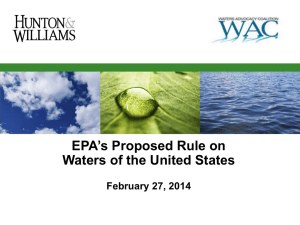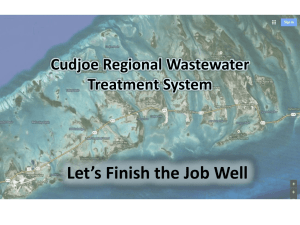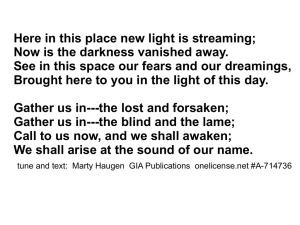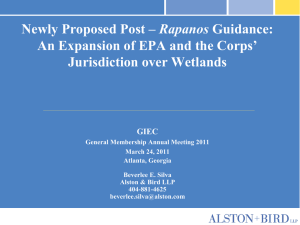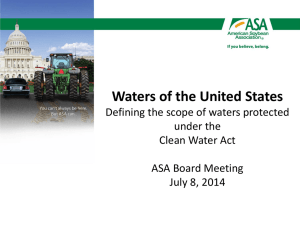PowerPoint Presentation for county use
advertisement
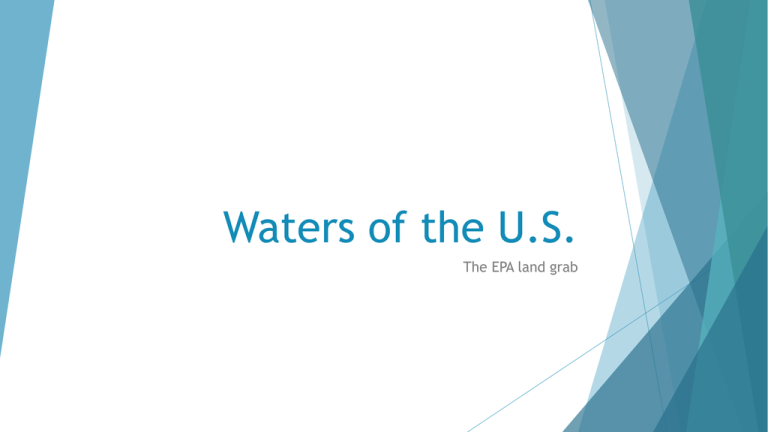
Waters of the U.S. The EPA land grab Background Water has always been regulated, either by states or the federal government. The federal law is the Clean Water Act. The U.S. Supreme Court in 2001 and 2006 handed down decisions reminding the EPA and the U.S. Army Corps of Engineers that the Clean Water Act limits federal power to “navigable waters.” Navigable waters are those that can carry boats or ships. Concluding that farm ditches, terraces or buffalo wallows are “navigable waters” is nothing more than a federal land grab. Background In 2001, the Supreme Court in SWANCC rejected regulation of “isolated waters” under the Migratory Bird Rule because the waters lacked a “significant nexus to navigable waters” Emphasized Congress’ use of the term “navigable” After SWANCC, the agencies adopted a broad interpretation that “waters of the U.S.” include any water “connected” to navigable waters Proposed Rule On March 25, 2014, EPA released a proposed rule Proposed Rule published in the Federal Register on April 21 Comments due July 21, 2014 Economic Analysis of Proposed Rule Interpretative Rule on 404(f)(1)(A) Exemptions WOTUS Under the Proposal 1. All waters currently, in the past, or may be susceptible to use in interstate or foreign commerce, including tidal waters; 2. All interstate waters, including interstate wetlands; 3. The territorial seas; 4. All impoundments of waters identified in 1-3 above; 5. All tributaries of waters identified in 1-4 above; 6. All waters, including wetlands, adjacent to waters identified in 1-5 of this section; and 7. On a case-specific basis, other waters, including wetlands, that alone or in combination with other similarly situated waters in the region have a significant nexus to a water identified in paragraphs 1-3 New Definitions in Proposal Tributary: Water body physically characterized by a bed and bank and ordinary high water mark which contributes flow directly or through other water bodies to waters in 1-4. A water does not lose its tributary status if there are man-made breaks (such as bridges, culverts, pipes, dams) so long as bed and bank can be identified upstream of the break. A wetland, pond, or lake can be a tributary, even if it lacks an OHWM and bed and bank, provided it contributes flow to 1-3. A tributary can be natural, man-altered, or man-made and includes rivers, streams, lakes, impoundments, canals, and ditches (unless excluded). New Category: Adjacent Water Adjacent: Bordering, contiguous, or neighboring waters separated from other WOTUS by dikes, or barriers are adjacent waters Neighboring: Waters located within a riparian area or floodplain or waters with a shallow subsurface connection or confined surface hydrologic connection Riparian area: Transitional areas between water and land where surface or subsurface hydrology influences the ecological process and plant community of the area … Floodplain: An area bordering inland or coastal areas that … is inundated during periods of moderate to high water flows Significant Nexus Definition Significant Nexus: Means a more than speculative or insubstantial effect that a water or wetland has either or alone or in combination with other waters in the region on waters 1-3. Other waters, including wetlands, are similarly situated when they perform similar functions and are located sufficiently close together so that they can be evaluated as a single landscape unit. All CWA Programs Proposed Rule is an end run around what Congress intended and two Supreme Court decisions Navigable defines the limits of federal regulatory control Congress provided a permit program for point sources and management/BMP programs for nonpoint sources that are lead by States 9 Permits = EPA Control Jurisdiction will result in severe restriction on farming and ranching – or even prohibit farming or ranching activities in any area the government determines to be a water Everything about this proposal serves to expand the federal regulatory reach Summary Tributary = anything with flow (including ditches) (bed, bank and OHWM) Adjacent Waters = waters that are “next” to any tributary including all waters in a floodplain and riparian area Other waters = otherwise isolated waters that can be aggregated with “other waters” within “single landscape unit” to find significant nexus 11 Which of these are “navigable” waters? These will be if the rule is finalized: Which of these are “navigable” waters? So will these: Are these “navigable” waters? We can’t be sure: Exclusion in Proposal Artificially irrigated areas that would revert to uplands should irrigation cease Artificial lakes or ponds created in dry land and used exclusively for stock watering, irrigation, settling basins, or rice growing Artificial reflecting pools or swimming pools created by excavating and/or diking dry land Small ornamental waters created by excavating and/or diking dry land for primarily aesthetic reasons Water-filled depressions from construction Groundwater, including groundwater drained through subsurface drainage systems Gullies, rills, and non-wetland swales Exclusions in Proposal Waste treatment systems, including treatment ponds or lagoons, designed to meet the requirements of the Clean Water Act; Prior converted cropland; Ditches excavated wholly in uplands and that drain only uplands and have less than perennial flow; and Ditches that do not contribute flow either directly or through other water bodies to a water in 1-3 above Agricultural Exemptions Continues existing statutory and regulatory exemptions from section 404 permitting requirements for normal farming, ranching, and silviculture practices where these activities are part of an ongoing farming, ranching, or forestry operation Issued “interpretive rule” immediately effective, adds 56 activities that are exempt from permitting requirements if consistent with Natural Resources Conservation Service (NRCS) conservation practice standards EPA and the Corps will enter into a Memorandum of Agreement with the NRCS to develop and implement a process for identifying, reviewing, and updating NRCS agricultural conservation practices and activities that would qualify for the exemption Agricultural Exemptions Exemptions apply only so long as the conservation activities are ongoing Do not apply if there is a change of use Once conservation activities are complete, landowner will likely have features that will be higher quality and more likely to be considered waters of the U.S. The agencies’ discussion of the agricultural exemptions is misleading and intended to minimize opposition to the rule Newly created permit exemptions, created by interpretive rule, nothing more than agency guidance, do not have the force of law Disingenuous to suggest that expanding the list of activities that are exempt from 404 permitting requirements mitigates the effect of the rule Agricultural Exemptions Interpretive rule has no effect on CWA jurisdiction: Its exemptions are not an exclusion from federal CWA jurisdiction Additional concerns with the agency’s approach: Activities are only exempt when conducted consistent with NRCS guidelines Who will inspect and enforce compliance with NRCS guidelines? Will third parties be able to challenge exempt status? EPA’s involvement in NRCS programs through development of the Memorandum of Agreement Is this an interpretive or a legislative rule under the Administrative Procedures Act? Why Does Jurisdiction Matter Enforcement/likelihood for potential illegal discharges Type of permit: General or individual “Federal action” triggers: NEPA, ESA, NHPA, 401 water quality certification, etc. Mitigation Third-party citizen suits What can you do? Write a letter (KFB can help, but using your own words is best) Respond with CapWiz on the KFB website Send the post card Write a letter to the editor (KFB can help) CONTACT: Ryan Flickner flicknerR@kfb.org 785-587-6327
